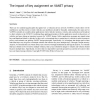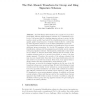58
Voted
SCN
2010
Springer
14 years 11 months ago
2010
Springer
59
Voted
SCN
2010
Springer
14 years 11 months ago
2010
Springer
69
Voted
SCN
2010
Springer
14 years 11 months ago
2010
Springer
124
click to vote
SCN
2010
Springer
14 years 11 months ago
2010
Springer
Abstract. A hidden vector encryption scheme (HVE) is a derivation of identity-based encryption, where the public key is actually a vector over a certain alphabet. The decryption ke...
96
Voted
SCN
2010
Springer
14 years 11 months ago
2010
Springer
The Canetti–Krawczyk (CK) and extended Canetti–Krawczyk (eCK) security models, are widely used to provide security arguments for key agreement protocols. We discuss security s...
88
Voted
SCN
2010
Springer
14 years 11 months ago
2010
Springer
In this work, we consider Authentication and Key Agreement (AKA), a popular client-server Key Exchange (KE) protocol, commonly used in wireless standards (e.g., UMTS), and widely c...
112
click to vote
SCN
2010
Springer
14 years 11 months ago
2010
Springer
We consider a collection of related multiparty computation protocols that provide core operations for secure integer and fixed-point computation. The higher-level protocols offer...
96
Voted
SCN
2010
Springer
14 years 11 months ago
2010
Springer
Group signatures is a powerful primitive with many practical applications, allowing a group of parties to share a signature functionality, while protecting the anonymity of the si...
102
click to vote
SCN
2010
Springer
14 years 11 months ago
2010
Springer
Aggregate message authentication codes, as introduced by Katz and Lindell (CT-RSA 2008), combine several MACs into a single value, which has roughly the same size as an ordinary MA...
98
Voted
SCN
2010
Springer
14 years 11 months ago
2010
Springer
The Fiat-Shamir (FS) transform is a popular tool to produce particularly efficient digital signature schemes out of identification protocols. It is known that the resulting signat...



